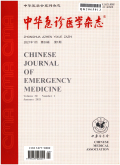急性上消化道出血患者既往出血次数与90 d全因死亡和再出血的关系:一项真实世界研究
Association between previous bleeding and 90-day mortality and rebleeding in patients with acute upper gastrointestinal bleeding: a real-world study
摘要目的:探讨既往出血史与急性上消化道出血患者的不良预后的关系。方法:本研究是一项前瞻性多中心真实世界临床研究(AUGUR研究),收集2020年6月30日至2021年2月10日全国20家三级医院因急性上消化道出血就诊于急诊科患者的资料。根据患者的既往出血次数,将患者分为三组(0次,1~3次和≥4次),将患者的人口学资料、临床特征、实验室资料、治疗转归等数据进行单因素分析及Logistic回归分析,探究既往的出血次数与消化道出血患者90 d死亡和再出血的关系。结果:本研究共纳入1 072例急性上消化道出血患者,所有患者的全因死亡率和再出血率分别为10.9%(117/1 072)和11.8%(129/1 072)。其中有712例(66.42%)患者既往无出血,有297例患者(27.71%)既往出血1~3次,有63例(5.88%)患者既往出血≥4次。在单因素分析中,年龄、入院生命体征及意识情况、既往肝硬化病史、以呕血起病、入院血红蛋白水平、静脉曲张所致出血、消化道溃疡所致出血、入院后输注红细胞、入院后进行气管插管及使用血管活性药均是90 d全因死亡和再出血的危险因素。经过多因素logistic回归分析显示,既往出血次数≥4次急性上消化道出血的患者90 d死亡( OR=2.17,95% CI:1.04~4.57, P=0.040)及再出血( OR=2.32,95% CI:1.19~4.53, P=0.013)的风险更高。 结论:既往出血次数≥4次是影响急性上消化道出血的患者90 d病死率及再出血率的独立危险因素。
更多相关知识
abstractsObjective:To investigate the relationship between previous bleeding history and poor prognosis of patients with acute upper gastrointestinal bleeding.Methods:This study was a prospective multicentre real-world study (Acute Upper Gastrointestinal Real-word study, AUGUR study). The data of patients with UGIB who were admitted to the emergency department of 20 tertiary hospitals in China from June 30, 2020 to February 10, 2021 were collected. According to the number of previous bleeding history, the patients were divided into three groups (0 time, 1-3 times, and≥4 times). Based on the patient’s demographic data, clinical characteristics, laboratory data, treatment, and outcomes, univariate and logistic regression analysis were performed to investigate the correlation between the number of previous bleeding and the 90-day mortality and rebleeding of patients with gastrointestinal bleeding.Results:A total of 1 072 patients with acute UGIB were included in this study. The all-cause mortality and rebleeding rate of all patients were 10.9% (117/1 072) and 11.8% (129/1 072), respectively. Among them, 712 patients (66.42%) had no previous bleeding, 297 patients (27.71%) had previous bleeding 1-3 times, and 63 patients (5.88%) had previous bleeding≥4 times. In univariate analysis, age, vital signs and consciousness on admission, history of liver cirrhosis, onset with hematemesis, admission hemoglobin, varicose veins bleeding, peptic ulcer bleeding, red blood cell infusion, tracheal intubation and the use of vasopressors after admission were risk factors for the 90-day mortality and rebleeding rate. Multivariate logistic regression analysis showed that patients with previous bleeding≥4 times had a higher risk of the 90-day mortality ( OR=2.17, 95% CI: 1.04-4.57, P=0.040) and rebleeding ( OR=2.32, 95% CI: 1.19-4.53, P=0.013). Conclusions:The history of previous bleeding≥ 4 times can be used as an independent risk factor for the 90-day mortality and rebleeding in patients with acute UGIB.
More相关知识
- 浏览240
- 被引30
- 下载168


相似文献
- 中文期刊
- 外文期刊
- 学位论文
- 会议论文



 换一批
换一批 换一批
换一批



